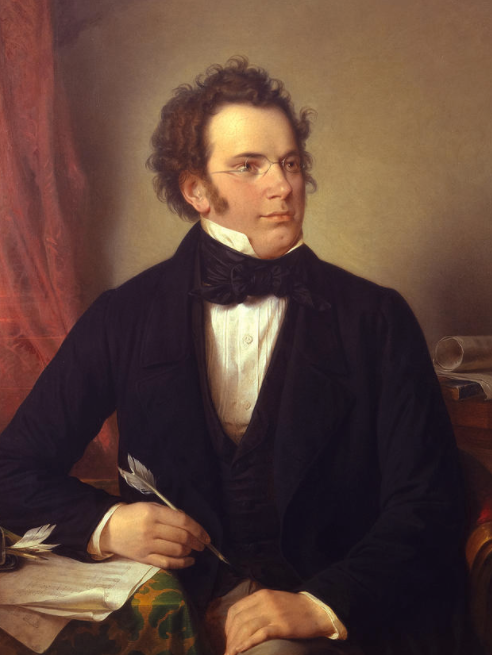Franz Schubert

Born: January 31, 1797, Vienna, Austria
Died: November 19, 1828, Vienna, Austria
String Quartet No. 14 in D Minor, D. 810, Death and the Maiden
- Composed: March 1824
- Premiere: January 29, 1826 at the home of Karl and Franz Hacker in Vienna and published in 1831
- Duration: approx. 40 minutes
“What I produce is due to my understanding of music and to my sorrows.”
—an entry from Schubert’s journal, March 1824
In the freezing cold January of 1797, Franz Schubert was born in the kitchen alcove (close to the only heat source) of a one-room apartment in the Zum roten Krebsen (“The Red Crab”) house. On that day he had a 50/50 chance of surviving his infancy. Of the 14 children born to Franz and Elisabeth only five survived. Late 18th-century Europe was a completely different world from the world we inhabit today. We take for granted our modern-day knowledge of hygiene and sanitation and how diseases are transmitted, but it wouldn’t have been common knowledge for the general European population of Schubert’s time. In fact, germ theory wouldn’t be a thing until the late 19th century. Ultimately, this lack of understanding of disease transmission and germs would lead to the untimely death of Franz Schubert at the young age of 31, likely of syphilis.
In some European cities, historians estimate that one in every five persons had syphilis, making the disease dramatically more common than it is today. Schubert seems to have been a man of excess—an excess of music, beauty, sorrow, depression and sex. “[Schubert's] body, strong as it was, succumbed to the cleavage in his—souls, I would put it, of which one pressed heavenwards and the other bathed in slime,” wrote Josef Kenner (a friend of Schubert’s) in 1858. Such powerful remarks from his friends suggest a life of promiscuity that likely led to Schubert’s contraction of syphilis. Penicillin, the treatment and cure for syphilis, would not be invented until 1928; therefore, in the 1820s, syphilis was a death sentence with most not surviving more than 10 years.
By March 1824, Schubert knew he was dying, and how much time he had left was unknown. In May 1823, Schubert penned these words, “annihilated I lay in the dust, / Scorched by agonizing fire, / My life’s martyr path, / Approaching eternal oblivion.” The race against death had begun and incited Schubert to greater compositional achievements. In the last six years of Schubert’s life, he composed some of his greatest works, including the song cycles Die schöne Müllerin and Die Winterreise, the Octet in F Major, the Impromptus for piano, the Great C Major Symphony and the string quartet, The Death and the Maiden.
The title of this string quartet (posthumously applied) and the theme of its second movement come from Schubert’s 1817 song, “Der Tod und das Mächen” (“The Death and the Maiden”). The song is a conversation between The Maiden and Death with the chordal Death theme bookending the one statement by The Maiden:
Maiden: “Pass me by! Oh, pass me by! / Go, wild man of bones! I am still young! Go, dear, / And do not touch me. /And do not touch me.”
Death: “Give me your hand, you beautiful and delicate creature! / I am a friend, and come not to punish. / Be of good courage! I am not wild, / You shall sleep softly in my arms!”
It is Death’s theme that Schubert brings to the String Quartet No. 14’s second movement, which has a theme and variation structure. Much like the entire work, each variation carries its own emotional expression from a lilting sadness to anger to moments of sheer joy.
The first movement is a rollercoaster of emotions beginning with the shouting and thundering introduction followed by agitation, which permeates the entire movement. But the second theme provides a dotted lyric melody that in the development transitions to a major key, providing a moment of light and joy.
The Scherzo and Trio third movement is a study in dramatic contrasts. The minor Scherzo is a fiery dance with melodic lines that overwhelmingly move downward, while the Trio moves to the parallel major key with a long sweeping melody. But an aspect of the Scherzo’s fire remains with the first violin.
The final movement is a very fast Italian dance called the tarantella. The common legend (now disproved) is that the tarantella was danced as a cure for the toxic spider bite, which caused madness and convulsions. Within this movement is a paraphrase or reference to another of Schubert’s famous songs, Erlkönig, , which tells the story of a young boy and his father pursued through the forest by the “Erlking” (a death character). The Erlking touches the boy, who dies in his father’s arms.
The last stanza of Schubert’s 1823 poem reads, “Take my life, my flesh and blood, / Plunge it all in Lethe’s flood, / To a purer, stronger life / Oh, great one, let it thrive.” Perhaps Schubert received his wish because, after his death, his music received a “stronger life” and has certainly thrived. 200 years after this string quartet’s creation and 4,704 miles away from Vienna, we will listen to this work on a cold January day in Cincinnati.
—Tyler M. Secor